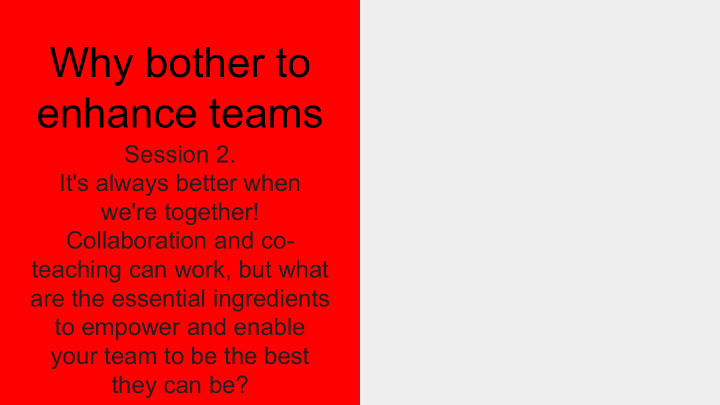



Why bother to enhance teams Session 2. It's always better when we're together! Collaboration and co- teaching can work, but what are the essential ingredients to empower and enable your team to be the best they can be?
Year 3! Year 1! Year 5! Year 4! Year 2!
Year 6! Your vision!
Is the job humanly possible?
Collaboration? (Marzano, 2003) Individual vs collaboration Percentile Entering Percentile Leaving Average school 50 50 Average teacher Highly ineffective teacher 50 3 Highly ineffective school Highly effective school 50 37 Highly ineffective teacher Highly ineffective school 50 63 Highly effective teacher Highly effective school 50 78 Average teacher Highly effective teacher 50 98 Highly effective school
Why are Demands of the job: teachers tired Children’s wellbeing and behaviour? and stressed? Over reporting? Poor collaboration? More release time Technology? More collaboration Digital technology Release time? (Remember Handwriting reports!) More TA’s More money
So is it possible to make the job better?
Plan less: share displays and lesson design Less stress Share responsibilities (and school committments) through Work to strengths (especially HBDI) collaboration Develop communication & collaboration skills Engage SIT Sprints Empower students Have a team weekend non- communication rule Work at school if at all possible
Success for Every Child! SIT’s SIT Sprint Agenda Protocols 84% response 100% support
Collaborative Teams a five step process 1. Student needs 2. HBDI profile 3. Experience , expertise and passions 4. Personal preference 5. Overall team dynamics
What could you start, stop and what has you wondering in team creation ?
We set up protocols for teams to explore their own and one another’s HBDI
We set up protocols for sharing...
Protocols For Growth Mindset
Protocols For Meetings Inquiry Question All meetings start with a 2-3 min check in Agenda item Decision / action for each item
Visible agenda (on the wall) Protocols Time estimates per item For Laptops down (no one can multitask!) Meetings 7 Norms personal and team focus Review at the end of the meeting
Protocols for talkers!
Think Pair, share Protocols First word, last word For 2,4,8 Meetings Team member observer Adaptive Schools...
PYPX Coaching Station Teaching Introducing Maths Co-teaching One teach on observe Inquiry Parallel teaching Coaching
Early days at KJS
Student led learning
Student centred?
ILE?
What indicators do you have of progress toward a more student centred environment ?
How can you gain commitment for collaborative action?
How to engage staff in collaborative change 1:5 protocol
The result is staff setting school direction... .. Sub committees with leadership support, accountability, researched based PL Time!
A moral imperative for a positive and collaboratively owned change process.
What is your moral imperative for change, improvement and collaboration at your school?
The leaders job? The school leader must have the expertise to create opportunities, develop trust, provide the resources needed to understand the impact on students of all the teachers (and their own impact as school leaders) and to lead these discussions among the teachers. Hattie 2015
The leaders job? Focus on what matters
SIT: ● Leader ● All teams have advocates ● 6-9 months Two of our Collaborative ● Afterschool 3 weekly strategies to bring about ● KISS change ● Enable Coherence School Improvement Teams SIT Sprint SIT: ● no leader & SIT Sprint ● expression of interest ● 30 days 3 days released 3 people ● explicit criteria and rigour ● mistake enabled ● report to Middle leadership with recommendations ● HBDI Profile ● Enables innovation
Learning Sprint: ● Team focus ● 3-5 student ● 3 weeks Focus on what ● Minute detail (sand) ● Designed to build matters: collaborative efficacy Learning ● report back to fellow teams Sprints Simon Breakspear
Collaboration doesn’t evolve spontaneously like combustion Hargreaves 2018
Relative to their own past performance, individuals will outperform themselves when working collaboratively. Furthermore, collaborative schools outperform individualistic schools and are characterised by sustained improvement (O’Reilly, 2016; Marzano, Waters & McNulty, 2005)
Want a great school? It is a lack of genuine and timely collaboration that is identified as limiting teacher potential and subsequently student learning outcomes (Elmore,2004; Levin & Fullan,2009).
Questions?
The national animal is a shy bird. Kiwis shy away from critical professional conversations for fear they might offend a colleague They are also shy about say “This went really well!”
Recommend
More recommend